Can Minimally Invasive Surgery Treat Scoliosis?
Two neurosurgeons with Och Spine at NewYork-Presbyterian explain how doctors can now provide surgical treatment for scoliosis with smaller incisions.

Scoliosis, a common and sometimes hereditary spinal condition, is a curvature of the spine that affects 2% to 3% of the population in the United States, or an estimated 6 million to 9 million people. However, in the elderly, scoliosis is present in nearly 68% of the population. Scoliosis can vary from a slight abnormality to an extreme curve that can affect how a person walks and moves. While most adults with scoliosis can use physical therapy or medication to manage the condition, some will need surgical solutions, which can involve fusing vertebrae together. But thanks to innovations in the field of minimally invasive surgery, scoliosis surgery in adults can now be safely performed with less invasive approaches.
Dr. Dean Chou, who leads the neurosurgical spine program at Och Spine at NewYork-Presbyterian Allen Hospital, and Dr. Ibrahim Hussain, a spine neurosurgeon with Och Spine at NewYork-Presbyterian/Weill Cornell Medical Center, spoke to Health Matters to explain how minimally invasive surgery works and how it’s now being used to treat scoliosis.

Dr. Dean Chou
What is minimally invasive surgery (MIS)?
Dr. Chou: The basic principles of MIS is that it achieves the same goals as open surgery, but with the minimal amount of tissue trauma during the approach and access to the spine.
Dr. Hussain: With some traditional open back surgery, you might make an incision down the middle of the back, dissect the muscle from the bone and put in retractors to pull the muscle to the side so you have access to the spine. With minimally invasive surgery, you can enter through smaller incisions and go between bundles of muscles and spread them apart to reach the spine, instead of cutting the muscles. That allows us to use tubes and endoscopes to do the same work we would do through the open surgery process.
Why is MIS more challenging for scoliosis?
Dr. Chou: First, MIS surgery for scoliosis is relatively new. The work is still in its infancy and we’re still learning what kinds of scoliosis cases are best suited for MIS. Second, MIS surgery for scoliosis merges two highly specialized fields, scoliosis surgery and minimally invasive surgery. To be successful, you have to be comfortable doing both open scoliosis surgery and minimally invasive spine surgery. Thus, surgeons should be facile in both types of surgery to meld the two fields.
Dr. Hussain: As a new generation of surgeons comes up, more will be trained in these minimally invasive techniques, and it will become another tool used more widely in the approach to spine or scoliosis surgery.
Who might be a good candidate for MIS?
Dr. Chou: The number one consideration for minimally invasive scoliosis surgery is if the person has good bone quality. Pain and disability are not necessarily correlated with the age of the patient or the severity of the abnormal curvature. You can be an active 80-year-old who plays tennis and has strong bones and you would be a good candidate, while someone who is 60 but sedentary and who has chronic illnesses would not be. So essentially if the patient has good bone quality and is otherwise functional except for the disabling pain or discomfort from their scoliosis, they would be a good candidate.
Dr. Hussain: One red flag that might indicate a patient is not a good candidate is if they are having surgery to revise a previous surgery. If vertebrae were fused in an abnormal way or if we have to remove old screws or hardware, these may be too complex for a minimally invasive approach.

Dr. Ibrahim Hussain
If you’re not a candidate for MIS, is open surgery the only other option?
Dr. Chou: You can still have minimally invasive surgery to treat your scoliosis, but you might not be able to have corrective surgery, which is when we try to straighten the spine. For instance, if someone with osteoporosis or heart or lung issues has severe leg pain from their scoliosis, we can use minimally invasive techniques to alleviate the leg pain, but we wouldn’t perform corrective surgery to address the entire scoliotic curve. In this way, MIS has actually opened the door for treatment for a lot of people who were otherwise not good candidates for surgery. They can still get the benefit of surgical treatment to reduce pain and discomfort without the risks of open, extensive surgery.
How do scoliosis patients do after undergoing MIS?
Dr. Chou: The outcomes data so far shows that if you do scoliosis surgery using minimally invasive techniques, the outcomes are just as good as with open scoliosis surgery in certain patient profiles. Specifically, research shows that MIS is just as effective for certain types of scoliosis; namely, degenerative scoliosis, or scoliosis in patients who are aging. Those patients do extremely well with minimally invasive scoliosis surgery compared with open surgery. However, this does not apply to all patients, and only certain patients have scoliosis that is amenable to MIS surgery.
Pain and disability are the primary reasons people seek care, so the number one outcome we look at is improvement in pain. We also look at improvement in mobility and functioning for the activities of daily life. Many of these patients have had results that are just as good with minimally invasive surgery as with open surgery; but again, these results are not universal and apply only to certain patients.
Dr. Hussain: As techniques and instrumentation evolve, and the longer we study MIS outcomes versus open surgery, the better we’ll understand not only what kind of scoliosis or spinal conditions we can treat, but also the long-term durability of these procedures.
What else should people know about scoliosis treatment?
Dr. Chou: If you need scoliosis surgery, not everyone needs their entire back fused. Some do need an extensive fusion, but what we really want to do is find the source of the pain, identify where it’s coming from, and target the surgical treatment. If we can restore function with a minimal amount of trauma and blood loss while speeding up recovery, that’s our goal.
Dr. Hussain: There are so many conservative treatments for scoliosis or spine conditions, and at Och Spine at NewYork-Presbyterian, the surgeons work closely with our non-operative colleagues to ensure patients have exhausted all treatment options before surgery is considered. This way, the doctors and patients are all on the same page in terms of the approach to surgery and the expectations of recovery.
Dean Chou, M.D., is Chief of the Spine Division in the Department of Neurosurgery at NewYork-Presbyterian/Columbia University Irving Medical Center and Professor and Vice Chair in the Department of Neurosurgery at Columbia University Vagelos College of Physicians and Surgeons. He also leads the neurosurgical spine program at Och Spine at NewYork-Presbyterian Allen Hospital. He has pioneered many minimally invasive surgical techniques to treat complex spine conditions and is also an expert in traditional open surgery. When possible, he uses the least-invasive treatment techniques, providing an individualized, thoughtful approach to every patient.
Ibrahim Hussain, M.D., is a spine neurosurgeon with Och Spine at NewYork-Presbyterian/Weill Cornell Medical Center and is an assistant professor of neurological surgery at Weill Cornell Medicine. He treats patients with the full spectrum of spinal disorders, including those with disc herniations, age-related degenerative arthritis, fractures, spinal cord injury, infections, primary and metastatic spinal tumors, congenital anomalies, and scoliosis. Dr. Hussain uses state-of-the-art intraoperative technologies that aim to make surgeries safer and less invasive.
Additional Resources
To learn more about Och Spine at NewYork-Presbyterian and the wide range of operative and non-operative services they offer, please visit: nyp.org/ochspine.
